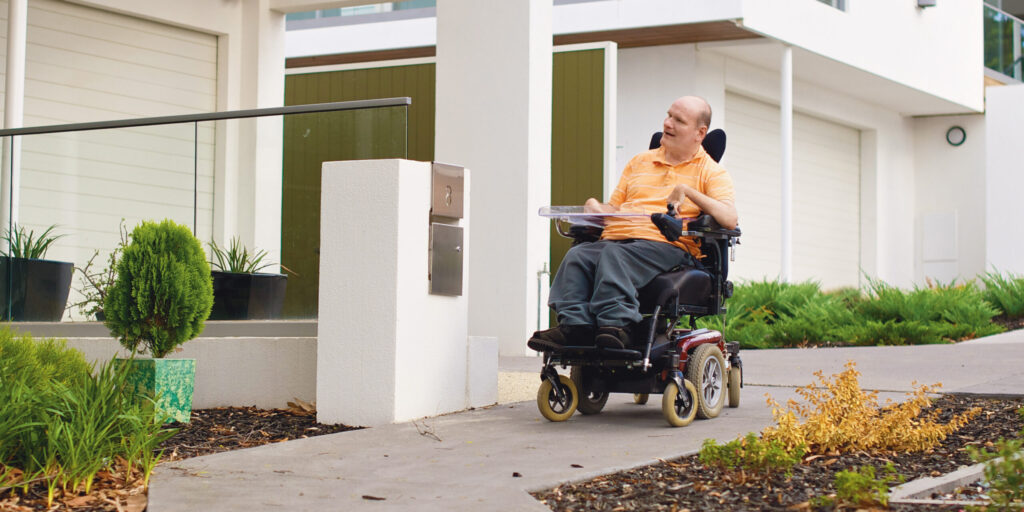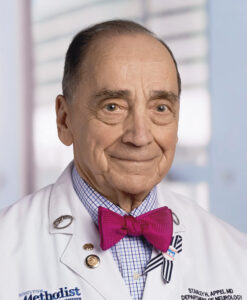
Understanding Amyotrophic Lateral Sclerosis
By MDA Staff | Friday, May 13, 2022
A Q&A with Stanley Appel, MD
Amyotrophic lateral sclerosis (ALS) is a degenerative motor neuron disease typically diagnosed in adults in middle age or later. About 18,000 people in the United States are currently living with ALS, making it one of the more common neuromuscular diseases, and yet there is still a lot for scientists to learn about why it occurs and how to treat it.
ALS is about 20% more common in men. Between 80% and 90% of ALS is sporadic, meaning there is no apparent cause, while 10% to 20% of cases involve a family history of the disease. Two-thirds of familial cases can be traced to an underlying genetic cause.
Quest talked with Stanley Appel, MD, who co-directs the Houston Methodist Neurological Institute in Texas, about how our understanding of ALS is changing.
What do we know about the genetic underpinnings of ALS?
There may be as many as 40 genes that could be dictating the disease, but most cases of the disease are related to just a few. The major one is C9orf72, which accounts for about 40% of familial cases, or 2% to 3% of all ALS diagnoses. In our clinic, we also find that almost 10% of patients with no family history of the disease have mutations in this gene.
So, if you have mutations in this gene, you’re going to get ALS?

Stanley Appel, MD
It’s not 100% certain that you will develop symptomatic ALS. While we know there are genes that predispose you to the disease, we also know there are genes that enhance resistance. So, if you’re carrying resistant genes, that may prevent you from getting it, even if you’re carrying the mutation.
Is there a way to shut off a disease-causing gene?
The answer is yes. It’s called antisense oligonucleotides (ASOs) and one, nusinersen (Spinraza), is FDA-approved for patients with spinal muscular atrophy (SMA) after studies demonstrated significant improvements in children receiving the treatment. There are two studies ongoing using ASOs for hereditary forms of ALS. These are not easy therapeutic trials because there’s a lot we keep learning as we try different ASOs. But there is a lot of promise and a lot of hope.
The progress we’ve made in not just understanding the genes that cause ALS, but in translating that understanding to what the genes do and how we can potentially correct them is astounding. It’s all based on the phenomenal success we’ve had with understanding SMA and the treatments we now have for it. This approach is really changing how we manage neuromuscular diseases. (Read about how research into neuromuscular diseases like SMA is translating into potential therapies for ultra-rare neuromuscular diseases in the Quest article “One in a Million.”)
How do environmental factors impact risk of developing ALS and how do they interact with genetic factors?
Numerous epidemiological studies have suggested a large number of environmental factors that could enhance the risk of developing ALS, including occupation, tobacco use, exposure to chemicals or radiation, electric shocks, sports, and physical injury. However, it is most likely that these factors act in the setting of genes that increase susceptibility and that environmental factors themselves do not initiate the disease.
Is the incidence of ALS increasing?
That question has been asked for the last 30 years or more. The answer is, we’re not sure. But there is increasing awareness of the disease, which is extremely important. For many years,
doctors took a long time before they recognized ALS or sent patients to a center like ours for diagnosis and therapeutic approaches. That’s much less common now with family doctors and internists getting patients to MDA Care Centers much faster.
The second thing is that people are living longer. So, we’re seeing people in their 80’s now who develop ALS and a whole range of other neurodegenerative diseases.
The combination of these two things tells us that the incidence probably isn’t increasing, but we now know more about the diagnosis in terms of onset and progression.
What is the biggest change you’ve seen in how ALS is managed?
One of biggest changes is the multidisciplinary care at MDA Care Centers. We realize how important this approach is, not just for the diagnosis but to address other issues, like breathing. It’s not enough to breathe in and out; the ability to take a deep breath is even more critical. When we find patients can’t take a deep breath even though they can still breathe, we put them on non-invasive ventilation, which insurance covers. This enhances their ability to expand their chest and lungs to get enough oxygen, so they don’t need supplemental nasal oxygen.
We’ve also learned the importance of swallowing, and that you are probably going to have to change your diet when you have ALS because if you choke or cough, it could lead to aspiration pneumonia.
Another problem we’ve come to recognize is that people with ALS who can walk usually have impaired balance. Even though you may think your legs are strong, your balance may be impaired. So, we work to prevent falls.
You take all of this and put them together with FDA-approved medications, and today our patients are living longer with better quality of life. And that makes a tremendous difference.
We also tell our patients that their ability to fight their disease emotionally goes a long way in how well they’re going to do. So, a positive attitude, an appropriate support group — these are critically important.
What are the most promising areas of study?
Most promising is the Healey Platform Trial, which is an exciting way to test multiple drugs against placebo rather than one at a time. Patients can switch to a different drug after six months following a washout period and being rescreened for the master protocol. It’s an exciting way to conduct a study.
We are also looking at how to suppress inflammation, which seems to be a driving force for disease progression. MDA, as well as the ALS Association and ALS Finding a Cure, are funding some of these studies.
We encourage all our patients to participate in a study because it gives hope. Hope is the most important thing that we can provide our patients. And the hope is being realized.
Find a clinical trial with MDA’s list of trials that are actively recruiting individuals to help advance research and treatment development.
TAGS: Antisense Oligonucleotide, Clinical Trials, Drug Development, Featured Content, Research, Spotlight
TYPE: Featured Article
Disclaimer: No content on this site should ever be used as a substitute for direct medical advice from your doctor or other qualified clinician.




